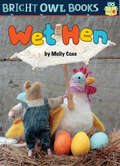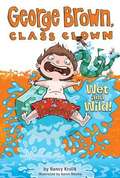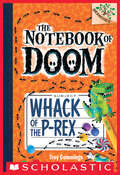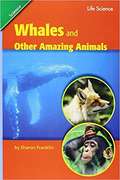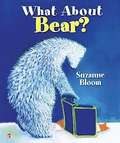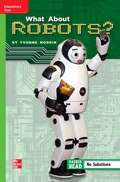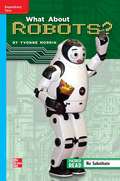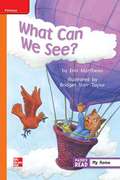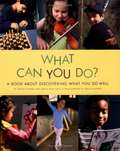- Table View
- List View
Wet Hen (Bright Owl Books)
by Molly CoxeHen and her eggs are wet. Luckily her friend Ben is there to help! This fun photographic easy-to-read story features the short"e" vowel sound. Kane Press's new series of super simple easy readers, Bright Owl Books, launches with Molly Coxe's five photographic stories, which feature the short vowel sounds and are each only around 100 words. These irresistibly silly stories help kids learn to read through repetition and by teaching the basic building blocks of reading—vowel sounds—giving kids the perfect start on educational success.
Wet and Wild! #5
by Nancy Krulik Aaron BlechaWhen George Brown spends the day at a water park, he ends up making a huge splash, just not the kind he intended. That's because trouble follows him like a shadow. It's not his fault. Really! Poor George is at the mercy of magic burps, burps that make him do wild and crazy things. Perfect for reluctant readers, this funny chapter book series is illustrated with more than forty black-and-white drawings that mirror the goofy mayhem. .
Whack of the P-Rex: A Branches Book (The Notebook of Doom #5)
by Troy CummingsAlexander Bopp is ready to battle Stermont's biggest monster yet -- the P-Rex!This series is part of Scholastic's early chapter book line called Branches, which is aimed at newly independent readers. With easy-to-read text, high-interest content, fast-paced plots, and illustrations on every page, these books will boost reading confidence and stamina. Branches books help readers grow!In this fifth book, Alexander stumbles into a VERY large footprint. And his friend Rip keeps finding candy in the street. What kind of monster leaves HUGE footprints behind? And where is all the candy coming from? Alexander, Rip, and Nikki must find out fast--before it's too late! This book is filled with humor, suspense, and zany black-and-white illustrations throughout!
Whales and Other Amazing Animals: Leveled Reader Grade 3. 3. 4 Advanced
by Sharon FranklinThe third installment of the Reading Street series, Grade 3, delivers structured content designed for children who have a firm foundation in English and Language Arts and are ready to continue on the path to lifelong reading. This curriculum for homeschooling brings together classic reading selections, fun activities and parent/teacher guides to help you develop lessons that boost your student's English and Language Arts learning. As with all levels of Reading Street, Grade 3 was created using educational research to ensure your child is guided through his or her work by age-appropriate and cutting-edge content. <P><P>Each week, your child will work through a series of reading and writing activities that center around a Big Idea. This structure supports your child's critical thinking skills and ensures he or she builds knowledge suitable for a child in third Grade.
What Animals Eat: Independent Reading Green 5 Non-fiction (Reading Champion #1143)
by Katie WoolleyThis story is part of Reading Champion, a series carefully linked to book bands to encourage independent reading skills, developed with Dr Sue Bodman and Glen Franklin of UCL Institute of Education (IOE)Reading Champion offers independent reading books for children to practise and reinforce their developing reading skills.Fantastic, original stories are accompanied by engaging artwork and a reading activity. Each book has been carefully graded so that it can be matched to a child's reading ability, encouraging reading for pleasure.
What Are Goods?
by Vicki Rushworth David Haggerty Michelle SchaubIn this book, learn what goods are, where they come from, and how they are transported to stores.
What Can We See? [Approaching Level, Grade 1]
by Bridget Starr Taylor Erin MatthewsNIMAC-sourced textbook
What Can You Do with a Paleta? (Elementary Core Reading)
by Carmen Tafolla Magaly MoralesNIMAC-sourced textbook
What Can You Do?
by Linda Lott Ginger NielsonThe fun and excitement of English and Language Arts learning continues in Grade 2 of Reading Street. This comprehensive and dynamic curriculum for homeschooling is geared toward young children who have some foundational English and Language Arts knowledge and are ready to strengthen their skills. Comprised of engaging activities, challenging content and weekly quizzes, Reading Street: Grade 2 is the next step in your child's path toward becoming a lifelong learner and reader. As with all Reading Street products, the Grade 2 system is formatted to help students meet certain age-appropriate goals. After completing this English and Language Arts homeschool program, your child should be able to: Read and comprehend two-syllable words. Identify common prefixes (such as pre-, un-, or re-) and suffixes (such as -able, -ad and -er). Correct mistakes made when reading out loud. Read books with two or more chapters. Understand the structure of stores (i. e. beginning, middle and end). Start selecting reading materials based on his/her own interests. Identify the "who," "what," "when," "where," "why" and "how" of the text. While the goals of second Grade English and Language Arts are numerous, Reading Street will help you craft engrossing lessons. Your child will garner important English and Language Arts skills while completing a workbook, reading stories and poems, and taking assessments. Planning these lessons will be easier than ever, as all Reading Street systems are broken down into weekly Big Ideas. All the work your child does on a given week is formulated around that single concept for an organized and challenging curriculum. With six easy-to-follow units, Reading Street: Grade 2 is the perfect tool for homeschooling parents. Your child will enjoy the reading selections and activities, and you'll love to see your student growing into a knowledgeable individual. We're confident that this product is the right one for you. For more information on the specific materials found in Grade 2 of Reading Street, check out the Features and Benefits page.
What Can You Do?: A Book About Discovering What You Do Well (Into Reading, Read Aloud Module 10)
by Shelley Rotner Sheila KellyNIMAC-sourced textbook <P><P>What Can You Do? is a book to help children discover their own special talents. Inspired by Dr. Howard Gardner's Frames of Mind, in which he outlines seven different kinds of intelligence, the book helps children realize that succes comes in many forms. While one child might excel in mathematics, another might shine as an actor or a painter. The top reader in the class may not be a good skier, and vice versa. The authors hope to offer children and the adults who care for them a chance to think and talk about ways children have met with success or difficulty in using their abilities, and to help them recognize that one ability is not better than another. This understanding will encourage children to seek help with their challenges and to delight in their strengths.

